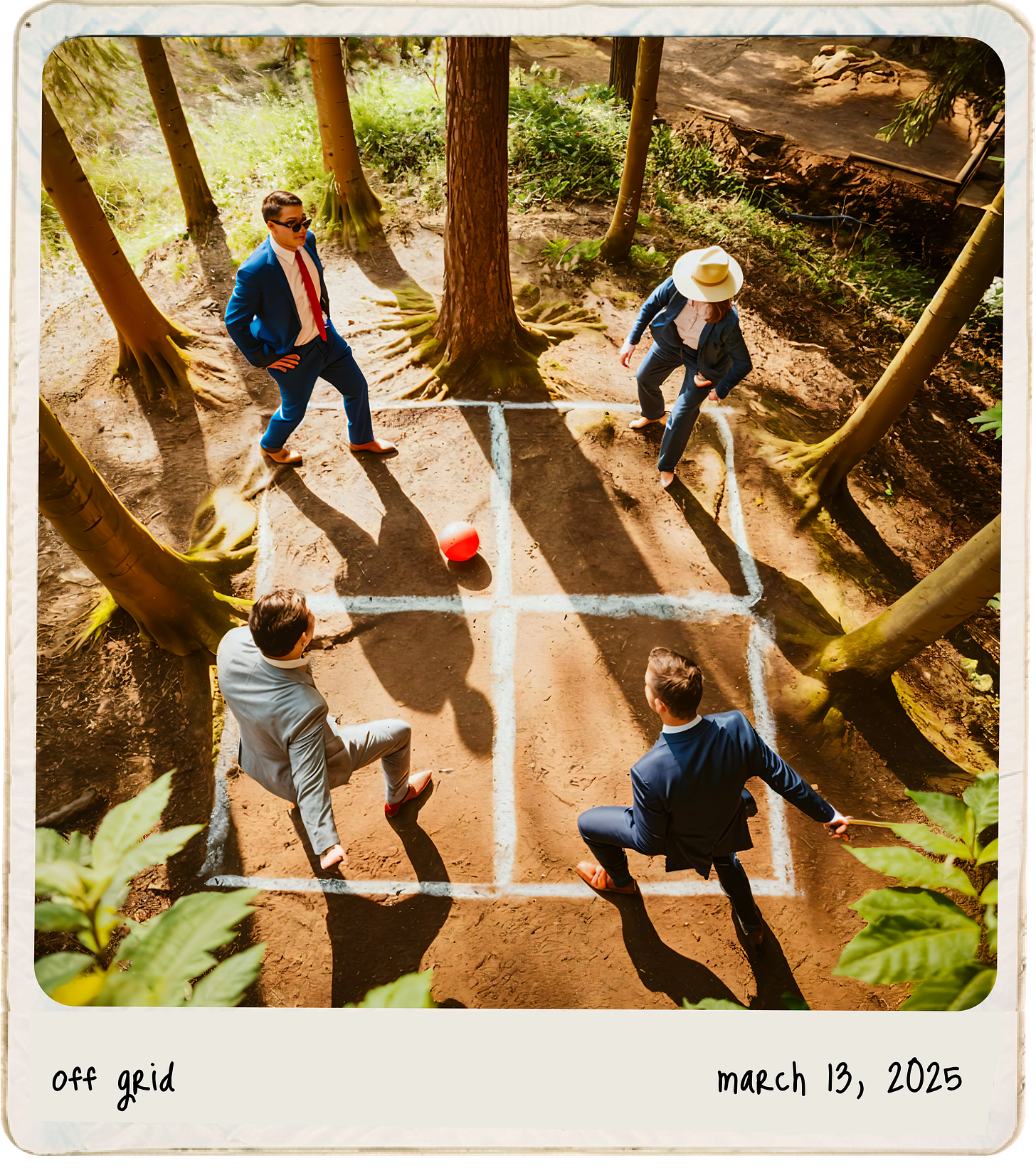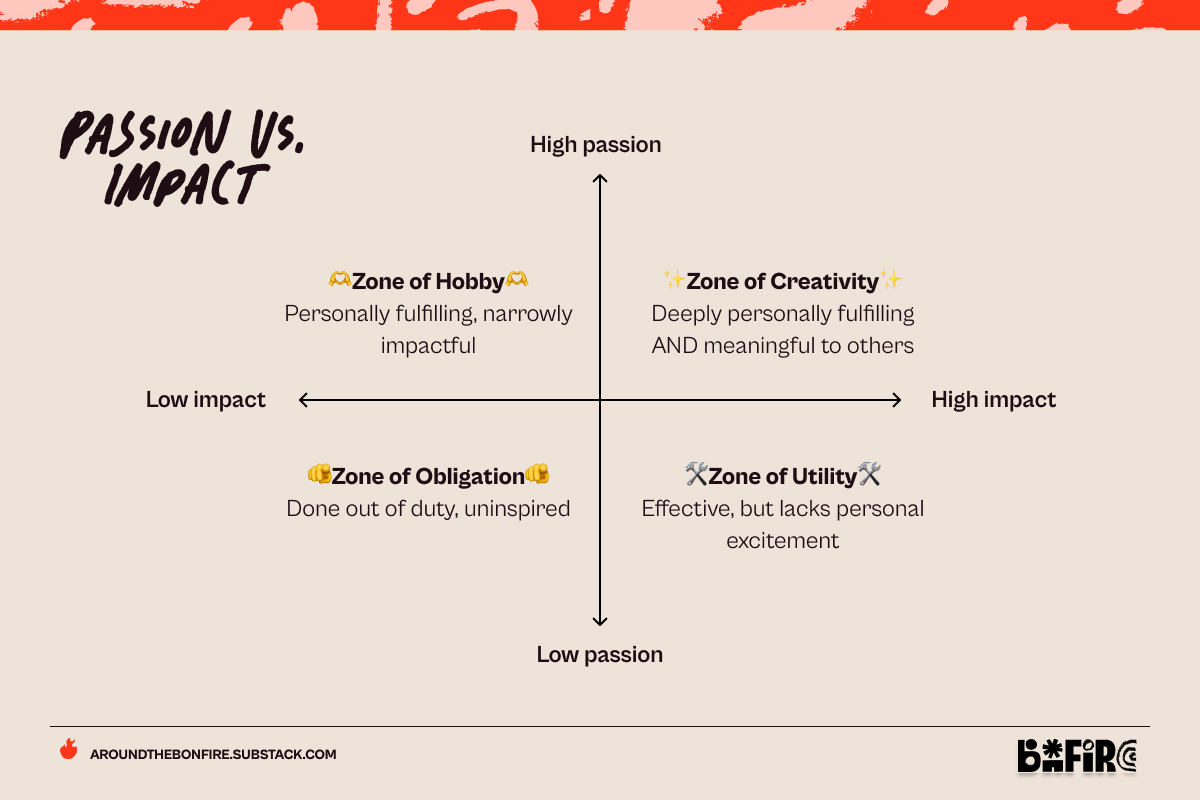75. In the zone: competence, chaos, passion, creativity
3 quadrant exercises to help you zero in on your most creatively fulfilled self
As a marketing director at a startup, I once temporarily reported into the CEO during a marketing leadership shakeup. Considering the man wasn’t a marketer, he very wisely and kindly recognized that he wasn’t going to have great guidance for my literal job during our 1:1s, but he could offer me some insights into my larger career trajectory.
At the time, I was feeling pretty ambivalent about the idea of even having a “career” at all, and I was downright disenchanted with marketing in general and my role in particular.
Given all the personnel changes, the business strategy changes, the changes to my own responsibilities, and the changes in my external life situation, it was hard for me to pinpoint exactly where the problem was. Did I just not like this company anymore? Was I done with this whole discipline? Did I want to get out of startups entirely? Like…how could I really separate symptoms from underlying problems?
This CEO had me do an exercise that I now recognize as a variation of the “Zone of Genius” framework popularized by Gay Hendricks in his book The Big Leap.
The CEO’s variation had me list out everything I do at work in a given week. Then, I plotted these things onto a matrix with two axes: enjoyment vs. competence.
It looked like this, and I made a slide where I stuck little boxes all over it that said things like “People management,” “Copywriting,” “Running meetings,” “Editorial planning,” “Booking webinar guests,” “Putting tasks in Asana,” “Managing up,” etc. etc.
Unsurprisingly, given how I was feeling at the time, I found I was spending a ton of my working hours in the Zone of Competence, doing things I was good at but didn’t enjoy.
Bummer.
There also weren’t many things in the Zone of Growth, which would have represented new interests, growing edges, and things I would be excited to experiment with and learn.
Basically, the graph said: Your motivation is in the toilet and there’s not much to do about it. I was stuck, the CEO told me, in a “competence trap,” because the things that were sitting in that Zone of Competence were the things that were business critical—it’s what they really needed me to do.
This exercise was an excellent diagnostic tool for thinking about what I did and didn’t want my role to be, and what I wanted more or less of in my next one. And it helped me be more mindful of how I could invest in my current role no matter how long it took me to find the next step.
In thinking about this exercise recently, it struck me that similar matrixed frameworks could be applied in different scenarios to help people diagnose and unlock their “zone of creativity.” Identifying the conditions, tasks, skills, and interests you have—or lack!—to help you stay creative or even just identify 🗣️🎶what in the eeeeeff 🎶 is going on with your feelings about a particular project.
Caveat: I’m not a sociologist or a business management researcher or anything, but there’s a proud history of, basically, randos writing questionable business advice books that go on to great popular success—and at least I’m not that!
So try on these three frameworks in different situations and see if they help you identify your ✨Zone of Creativity™️©✨, which I’m using to mean the optimal operating zone across many different intersections!
1. Originality vs. skill: Find your strengths
Example use cases:
Great when you’re wondering if you need more practice or should push for more originality.
Helpful when you feel "stuck" making competent but uninspired work.
Useful for moving from imitation to innovation.
Useful for evaluating a varied list of ideas for addressing a particular problem or project.
Examples of what you’ll plot on the graph:
A list of all your regular work tasks, or
All your current creative activities/projects, or
A raw list of ideas/approaches to solve a particular problem or fill a brief, e.g. all the different campaign concepts you might make
What you might learn:
If you have lots of tasks, ideas, activities, or responsibilities in the…
Zone of Competence: You might be in a "comfort zone" and need to take more risks.
Zone of Experimentation: Your raw creativity is strong, but you may need to refine your craft or just embrace that you’re in a learning period.
Zone of Imitation: You might want to lean into bolder, more divergent ideas…or maybe this is where you need/want to be for now because you’re trying to directly compete with another company or personally learn by doing!
Zone of Creativity: ::party::
2. Passion vs. impact: Align your inspiration with meaning
Example use cases:
Ideal for if you’re optimizing for work that’s fulfilling and resonating with others.
Helps you decide whether to pursue creative work as a career or keep it as a passion project.
Useful for brands or content creators trying to gauge whether they’re making work that matters.
Examples of what you’ll plot on the graph:
A list of all your regular work tasks, or
All your current creative activities/projects, or
A raw list of ideas/approaches to solve a particular problem or fill a brief, e.g. all the different campaign concepts you might make
What you might learn:
If you have lots of tasks, ideas, activities, or responsibilities in the…
Zone of Hobby: You might be making beautiful work that isn’t connecting with an audience—maybe you need stronger marketing or storytelling. (Or maybe this is great because you only want to invest in your personal creativity process at the moment!)
Zone of Utility: You might be successful but creatively unfulfilled. Maybe it's time to pivot toward work that excites you!
Zone of Obligation: You’re probably not going to be able to simply walk away from all the things here, but knowing what’s already here can help you establish a better balance!
Zone of Creativity: Hell yeah.
3. Mastery vs. risk: Balance growth and expertise
Example use cases:
Great for trying to push creative boundaries and grow as a creative.
Helps you see if you’re playing it too safe or taking risks without enough skill.
Useful for anyone shifting between structured work (client projects, in-house work) and personal exploration (passion projects, experimental work).
Examples of what you’ll plot on the graph:
A list of all your regular work tasks, or
All your current creative activities/projects, or
A raw list of ideas/approaches to solve a particular problem or fill a brief, e.g. all the different campaign concepts you might make
What you might learn:
If you have lots of tasks, ideas, activities, or responsibilities in the…
Zone of Professionalism: You may be making polished work but not innovating. Time to take risks?
Zone of Chaos: You have bold ideas but they might need more refinement. What professional development, classes, or training could you take?
Zone of Blandness: It’s time for an all-around level-up! Make it a goal to move toward either the Zone of Professionalism (by upskilling), or Zone of Chaos (by getting inspired).
Zone of Creativity: 😎
Over to you…
What do you think about applying these graphs to your work or creative pursuits? Which seems most helpful? We’d love to know!
For more…
Follow us on LinkedIn and on Instagram. Stay tuned to our Substack space for new community features and ways to meet your fellow subscribers.
And let us know if you’d like to go deeper with us to talk about you and creativity. We do:
1:1 coaching and mentorship
Team workshops and consulting for marketing and leadership
Speaking and appearances on podcasts and at events








